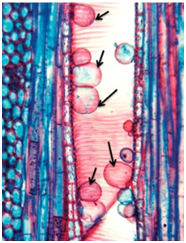In the given diagram:

1. the lighter outer area is the heart wood or alburnum and is mechanically strong, resistant to decay, and less easily penetrated by wood-preservative chemicals
2. the lighter outer area is the Sapwood or alburnum and is involved in transport of water and minerals to the crown of the tree
3. the darker inner area is the heart wood or duramen and is involved in transport of water and minerals to the crown of the tree
4. the darker inner area is the sap wood or duramen and is mechanically strong, resistant to decay, and less easily penetrated by wood-preservative chemicals

The following diagram shows the anatomy of the root of an epiphytic orchid. The function of the structure marked X is:
1. Photosynthesis
2. Storage
3. Protective
4. Repair and healing
The balloon like structures seen in vessels in the given diagram are called as:

1. Tyloses
2. Hydathodes
3. P proteins
4. Lenticells
In the given diagram showing the anatomy of a tree trunk, what are A, B, C and D respectively?
| 1. | Secondary xylem, Secondary phloem, Periderm, Bark |
| 2. | Secondary phloem, Secondary xylem, Periderm, Bark |
| 3. | Secondary xylem, Secondary phloem, Phellem, Periderm |
| 4. | Secondary phloem, Secondary xylem, Phellem, Periderm |
In the section of a monocot leaf shown in the given diagram, what would be true for the structures labeled X?
| 1. | They regulate the opening and closing of the stomata in the adaxial surface of the leaves |
| 2. | Due to presence of lignin in their walls they provide support to the leaf surface in windy conditions |
| 3. | They are involved in folding and unfolding of leaf tissue to control light intensity and reduce overall water loss |
| 4. | They are abnormal cells produced during healing of the adaxial surface after injury and are common portals of entry of viruses into the plants |
In the given diagram if xylem is represented by 1, the companion cells will be represented by:
1. 2
2. 3
3. 4
4. 5
A nail is driven in the trunk of a young tree, about 4 meters tall, at a height of about 2 meters from the ground. In a few years the tree grows to a height of 20 meters. What would be the height of the nail from the ground now?
| 1. | 2 meters | 2. | 10 meters |
| 3. | 12 meters | 4. | 18 meters |
What type of vessels are you most likely to see in metaxylem of a stem?
| 1. |  |
2. |  |
| 3. |  |
4. |  |
In the transverse section of a young dicot stem, the term ‘hard bast’ will be used for the structure labeled:
| 1. | A | 2. | B |
| 3. | C | 4. | D |
Vascular bundles are continuous from the root to the stem, but different arrangements are found in two cases. What would be true for this arrangement?
| 1. | In the stem they are collateral with endarch xylem while in the root they are radial with exarch xylem |
| 2. | In the stem they are collateral with exarch xylem while in the root they are radial with endarch xylem |
| 3. | In the stem they are radial with endarch xylem while in the root they are collateral with exarch xylem |
| 4. | In the stem they are radial with exarch xylem while in the root they are collateral with endarch xylem |












